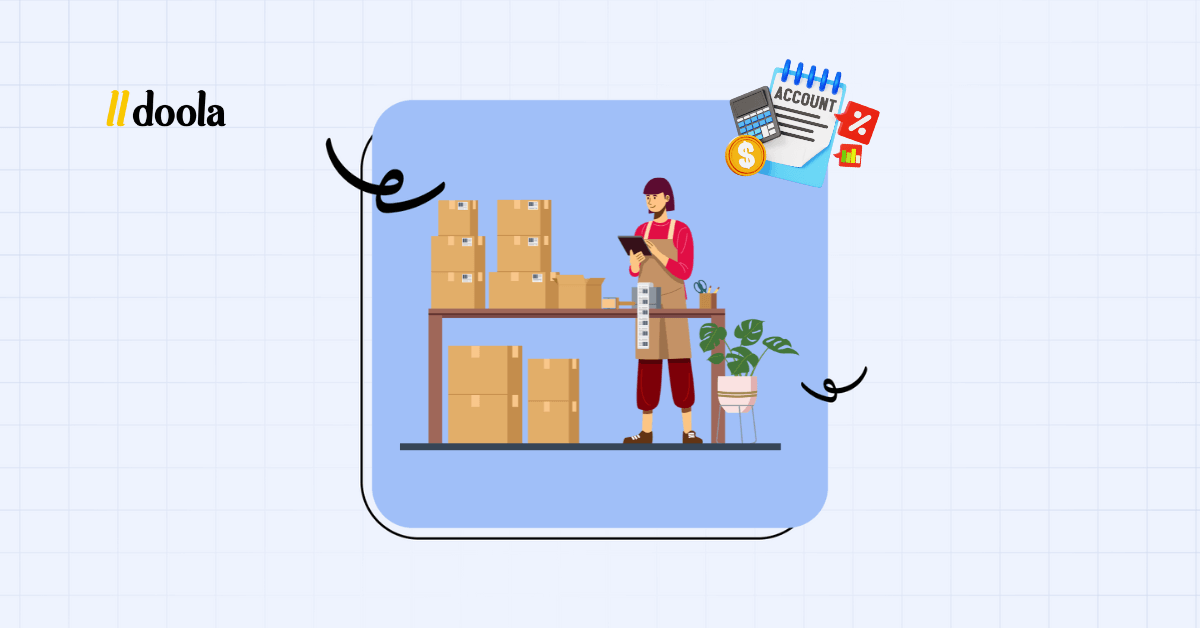
You just bought a $10,000 piece of equipment for your growing business, but it’s not going to last forever.
So, how do you account for its shrinking value over time? That’s where depreciation comes in.
But what if your asset, like a tech device, delivery van, or specialized machinery, loses value faster in its early years?
That’s when the Double Declining Balance (DDB) Method could be your secret weapon.
The DDB method is an accelerated depreciation approach that front-loads the expense, reducing taxable income sooner and improving cash flow during your early growth stages.
This is really helpful for startups and e-commerce sellers who need to maximize every financial advantage.
In this guide, we’ll explain how the Double Declining Balance Method works in simple terms, compare it with other depreciation methods, and provide step-by-step examples.
And if you want to avoid the spreadsheet headaches altogether, doola Bookkeeping can help you manage depreciation automatically and stay tax-compliant, without lifting a finger.
How Does the Double Declining Balance Formula Work?
At first glance, the Double Declining Balance (DDB) formula may look a little intimidating. But it’s just a faster way of writing off the value of an asset, especially in its earlier years.
Formula:
DDB depreciation = 2 × straight-line rate × book value at the beginning of the year
Let’s break that down:
- Straight-line rate: This is the standard rate of depreciation per year if you were using the basic straight-line method. For example, if your asset has a useful life of 5 years, your straight-line rate is 1 ÷ 5 = 20%.
- Book value: The current value of the asset at the start of the year, after previous depreciation.
- 2×: The “double” in Double Declining Balance. It simply means you’re depreciating the asset twice as fast compared to the straight-line method.
📌 Pro Tip: The DDB method ignores salvage value until the final year. This means you’ll keep depreciating the asset until its book value is close to the estimated salvage value, then adjust accordingly in year 5.
Let’s say you bought a $10,000 machine with a useful life of 5 years.
| Year | Beginning Book Value | Depreciation (20% × 2 × Book Value) | Ending Book Value |
| 1 | $10,000 | $4,000 | $6,000 |
| 2 | $6,000 | $2,400 | $3,600 |
| 3 | $3,600 | $1,440 | $2,160 |
| 4 | $2,160 | $864 | $1,296 |
| 5 | $1,296 | Adjust for Salvage Value* | Final Value |
This helps you write off more early, which can lower your taxable income in your most cash-strapped years, which is great for businesses investing in high-depreciation equipment.
Double Declining Balance Method vs. Straight-Line Depreciation
The Double Declining Balance (DDB) and Straight-Line methods are the two most popular, but they serve very different purposes.
When it comes to depreciation, there’s no one-size-fits-all. Here’s a quick breakdown to help you decide what works best for your business:
| Feature | DDB Method | Straight-Line Method |
| Speed of Depreciation | Fast (more upfront) | Even (spread evenly over the years) |
| Best For | Tech, machinery, electronics | Furniture, real estate, and signage |
| Tax Impact | Higher deductions early on | Predictable deductions annually |
| Cash Flow Benefit | Immediate savings in the early years | No front-loaded savings |
| Complexity | More calculation effort | Simple and easy to manage |
Which One Should You Use?
If you’re a startup or small business investing in high-tech or quickly aging assets like computers, packaging equipment, or 3D printers.
DDB lets you depreciate those items faster and lower your taxable income in the years when you need every dollar to reinvest.
But if you’ve bought long-term, slow-depreciating assets like office furniture, fixtures, or property, the straight-line method provides a cleaner and more consistent expense line on your books.
The DDB method can create early tax savings and improve cash flow for growing startups, especially those still building their profit margins.
When Should Small Businesses Use the Double Declining Balance Method?
The Double Declining Balance (DDB) method isn’t a must for every business but in the right scenarios, it can give you a serious advantage.
Here’s when it’s worth considering:
Use DDB if:
✔️ You’re investing in high-tech or short-life equipment
Tech gear, packaging machines, or software tools often lose value quickly. DDB helps your books reflect that reality.
✔️ You need early-stage cash flow relief
Higher depreciation in the early years = lower taxable income = more money left in your account during growth phases.
✔️ You’re planning a funding round
Lower reported profits (due to front-loaded depreciation) can make your business look less profitable on paper—potentially minimizing taxes without affecting your operational reality.
Insight: Startups that invest heavily in tech infrastructure often benefit from DDB’s early write-offs. It’s a smart move for bootstrappers trying to preserve runway.”
Avoid DDB if:
⚠️ You rely on simple bookkeeping software without customization
Some platforms don’t support DDB out-of-the-box, which can lead to manual errors or inconsistent reporting.
⚠️ You need consistent net income year-to-year
If you’re working with lenders or investors who prefer predictability, the even depreciation of straight-line might be a better fit.
⚠️ Your assets depreciate slowly
Think furniture, real estate, or vehicles with long useful lives. The DDB method may exaggerate the expense timeline in these cases.
Step-by-Step Example of the DDB Method in Action
Let’s say you’re an e-commerce seller who buys a $10,000 packaging machine to speed up fulfillment.
You expect to use it for 5 years, and it has a salvage value of $1,000 at the end of its useful life. Here’s how depreciation using the Double Declining Balance (DDB) method would work.
First, calculate the straight-line rate:
Straight-line rate = 1 / Useful life = 1 / 5 = 20%
DDB rate = 2 × 20% = 40%
DDB Depreciation Schedule
| Year | Beginning Book Value | Depreciation Expense (40%) | Ending Book Value |
| 1 | $10,000 | $4,000 | $6,000 |
| 2 | $6,000 | $2,400 | $3,600 |
| 3 | $3,600 | $1,440 | $2,160 |
| 4 | $2,160 | $864 | $1,296 |
| 5 | $1,296 | $296 | $1,000 (salvage) |
Year 1 Callout: Major expense hit but also a major tax deduction when you need it most.
Year 5 Callout: You stop at the salvage value, no over-depreciating. This is where the final year adjusts to make the math line up.”
Here’s a quick recap:
- DDB accelerates depreciation up front, giving you bigger deductions early.
- It eventually tapers off, ensuring your asset never goes below its expected salvage value.
- This is ideal for assets that lose usefulness fast like tech or equipment in high-growth e-commerce.
📌 Pro Tip: Keep an eye on your asset schedules and avoid over-depreciation. The final year usually requires a manual adjustment to ensure you don’t dip below salvage value.
Pros and Cons of the Double Declining Balance Method
The Double Declining Balance (DDB) method offers strategic advantages, especially for startups and fast-scaling small businesses, but it also comes with a few tradeoffs.
Here’s a balanced look:
Pros
- Front-Loaded Tax Deductions: DDB allows you to deduct more in the early years, which means lower taxable income when you need cash most usually during your startup or growth phase.
- Matches Real-World Depreciation: For equipment or technology that loses value quickly, DDB better reflects actual wear and tear. Your books will align more closely with reality.
Cons
- Complexity in Calculation: Unlike the straight-line method, DDB requires recalculation each year and an adjustment in the final year to account for salvage value. It’s not beginner-friendly.
- Not for Every Asset: DDB isn’t ideal for long-lasting assets like office furniture, buildings, or intangible assets. For those, even depreciation makes more sense.
📌 Pro Tip: Not all accounting tools. You may need to make manual entries or work with a dedicated bookkeeper to avoid mistakes.
Common Mistakes to Avoid When Using the DDB Method
The Double Declining Balance method can be a powerful depreciation strategy but only if used correctly.
Many small business owners make avoidable mistakes that can trigger audit red flags or lead to inaccurate books. Here are the most common pitfalls:
Forgetting to Stop at Salvage Value
DDB doesn’t account for salvage value each year but it still must not depreciate an asset below that amount. Many users miss this final adjustment, resulting in over-depreciation.
Using the Wrong Useful Life
Your depreciation is only as accurate as the useful life you assign to the asset. Overestimating or underestimating it skews your deductions and distorts your balance sheet.
Switching Depreciation Methods Midway
Unless you have a valid reason and proper documentation, switching from DDB to straight-line (or vice versa) mid-asset lifecycle can violate IRS consistency rules and create audit risk.
Not Recording Adjustments Year by Year
Because DDB recalculates based on the asset’s declining book value, you must update your depreciation calculation annually. Skipping this step breaks the method entirely.
Misclassifying the Asset
Using DDB on the wrong type of asset, like long-lived infrastructure or intangible assets, can mislead investors, distort financials, and lead to poor business decisions.
📌 Pro Tip: IRS rules require consistency. Once you choose a depreciation method for an asset, you must continue with it unless you get approval to change. Documentation matters.
If you’re unsure whether you’re depreciating correctly, a bookkeeper can help you avoid costly mistakes, from catching salvage value errors to choosing the right method for your asset type.
When to Consider a Bookkeeper for Depreciation Tracking
Depreciation might sound like a back-office detail, but getting it wrong can cost you big time. So the main thing you’ve to asked yourself:
- “Have I missed depreciation entries before tax time?”
- “Am I tracking my business assets correctly?”
- “Do I even know which depreciation method I’m using?”
If the answer to all of the above is a yes, it might be time to call in a pro. The reality is that depreciation tracking isn’t just about compliance it’s about clarity.
For example, a Shopify store owner investing in warehouse automation switched from straight-line to Double Declining Balance with the help of a bookkeeper.
The result? A $2,000 tax savings in their first year simply by optimizing how their equipment was depreciated.
When you understand what your business is worth and what you can deduct, you make smarter decisions, faster.
A good bookkeeper helps you stay compliant while maximizing your deductions. And with doola Bookkeeping, that help is just a click away.
Try doola Bookkeeping for Stress-Free Accounting

Depreciation doesn’t have to be a headache. With doola Bookkeeping, small business owners get powerful, founder-friendly tools that simplify every part of accounting.
From tracking fixed assets to filing taxes on time, here’s how doola helps you stay on top of depreciation:
✅ Automated tracking of fixed assets so you never miss a deduction
📊 Clean, monthly reports with built-in depreciation schedules
🧾 Audit-ready books that keep you compliant and investor-friendly
🌍 Support for global founders managing U.S.-based operations
Sign up today to get depreciation handled the right way.
FAQs

What’s the difference between declining balance and double declining balance?
The declining balance method applies a fixed percentage to the asset’s book value each year.
The double declining balance method accelerates this by using twice the straight-line depreciation rate, allowing for larger deductions in the early years of an asset’s life.
Can I switch from straight-line to double declining?
Technically, yes. But switching methods midstream requires proper documentation and may not be allowed for tax purposes without IRS approval.
It’s best to consult a bookkeeper or tax advisor before making any changes to ensure consistency and compliance.
Is DDB allowed for tax purposes?
Yes, the IRS allows the double declining balance method for tax reporting under the Modified Accelerated Cost Recovery System (MACRS).
However, there are specific rules based on asset type, so it’s important to verify if your asset qualifies.
How do I track DDB depreciation in QuickBooks/Excel?
In QuickBooks, you may need to manually adjust journal entries if DDB isn’t supported by default.
In Excel, use the formula: DDB = 2 × (1/useful life) × beginning book value.
Maintain a schedule to track annual depreciation and stop when the asset reaches salvage value.



